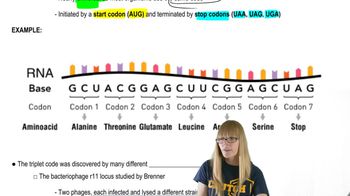Table of contents
- 1. Introduction to Genetics51m
- 2. Mendel's Laws of Inheritance3h 37m
- 3. Extensions to Mendelian Inheritance2h 41m
- 4. Genetic Mapping and Linkage2h 28m
- 5. Genetics of Bacteria and Viruses1h 21m
- 6. Chromosomal Variation1h 48m
- 7. DNA and Chromosome Structure56m
- 8. DNA Replication1h 10m
- 9. Mitosis and Meiosis1h 34m
- 10. Transcription1h 0m
- 11. Translation58m
- 12. Gene Regulation in Prokaryotes1h 19m
- 13. Gene Regulation in Eukaryotes44m
- 14. Genetic Control of Development44m
- 15. Genomes and Genomics1h 50m
- 16. Transposable Elements47m
- 17. Mutation, Repair, and Recombination1h 6m
- 18. Molecular Genetic Tools19m
- 19. Cancer Genetics29m
- 20. Quantitative Genetics1h 26m
- 21. Population Genetics50m
- 22. Evolutionary Genetics29m
11. Translation
The Genetic Code
Problem 3b
Textbook Question
Assuming the genetic code is a triplet, what effect would the addition or loss of two nucleotides have on the reading frame? The addition or loss of three, six, or nine nucleotides?
 Verified step by step guidance
Verified step by step guidance1
Understand that the genetic code is read in triplets, known as codons, each of which codes for a specific amino acid.
Recognize that adding or removing nucleotides in numbers not divisible by three (e.g., one or two nucleotides) will cause a frameshift mutation, altering the reading frame and potentially changing every subsequent codon.
Consider that the addition or loss of two nucleotides will shift the reading frame, leading to a completely different sequence of amino acids from the point of mutation onward.
Realize that adding or removing nucleotides in multiples of three (e.g., three, six, or nine nucleotides) will not cause a frameshift, as the reading frame remains intact, though it may result in the addition or deletion of one or more amino acids.
Conclude that while frameshift mutations can have drastic effects on protein function, the addition or loss of nucleotides in multiples of three may have less severe effects, depending on the specific amino acids involved.
Recommended similar problem, with video answer:
 Verified Solution
Verified SolutionThis video solution was recommended by our tutors as helpful for the problem above
Video duration:
4mPlay a video:
Was this helpful?
Key Concepts
Here are the essential concepts you must grasp in order to answer the question correctly.
Reading Frame
The reading frame refers to the way nucleotides in DNA or RNA are grouped into codons, which are sets of three nucleotides that correspond to specific amino acids during protein synthesis. The reading frame is crucial because it determines how the sequence is interpreted by ribosomes. A shift in the reading frame can lead to entirely different amino acid sequences, potentially resulting in nonfunctional proteins.
Recommended video:
Guided course

The Genetic Code
Frameshift Mutation
A frameshift mutation occurs when nucleotides are added or deleted from the genetic sequence, altering the reading frame. If one or two nucleotides are added or lost, the entire downstream sequence is misread, leading to a completely different set of amino acids. In contrast, the addition or loss of three nucleotides typically results in the addition or loss of one amino acid without shifting the reading frame.
Recommended video:
Guided course

Point Mutations
Codon and Genetic Code
A codon is a sequence of three nucleotides that encodes a specific amino acid or a stop signal during protein synthesis. The genetic code is the set of rules by which information encoded in genetic material is translated into proteins. Understanding codons is essential for grasping how mutations, such as those caused by nucleotide additions or deletions, can affect protein structure and function.
Recommended video:
Guided course

The Genetic Code

 11:43m
11:43mWatch next
Master The Genetic Code with a bite sized video explanation from Kylia Goodner
Start learningRelated Videos
Related Practice

